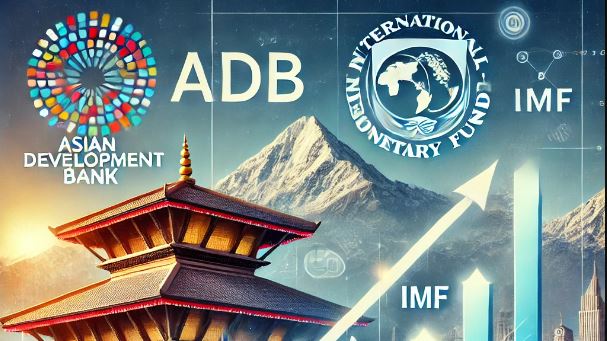KATHMANDU: Nepal’s economy is showing early signs of recovery, with multilateral international financial institutions projecting positive trends for the future. Based on recent data provided by the government, institutions like the Asian Development Bank (ADB) and the International Monetary Fund (IMF) have indicated that Nepal’s economy is on a path toward stability, though caution remains about external influences that could disrupt this progress.
According to the ADB, the country’s economic indicators are turning positive, and if external conditions remain stable, Nepal is expected to experience a steady recovery. The bank’s projections show that the service and agriculture sectors will be the main contributors to economic growth.
ADB Predicts 4.9% Economic Growth
The Asian Development Bank has forecast a 4.9% growth rate for Nepal’s economy in the current fiscal year. A key factor driving this recovery is the gradual return of foreign tourists, whose presence is helping boost demand in various sectors, especially hospitality, transportation, and food. The increase in tourist arrivals, which had sharply declined due to the COVID-19 pandemic, is now driving internal demand across several industries, leading to positive spillover effects throughout the economy.
The rise in tourism is particularly important for Nepal’s service sector, which includes hotels, restaurants, and travel agencies. These industries have started to bounce back, with tourist inflows increasing demand for food, accommodations, and services. This uptick is seen as an essential step in bolstering the overall economic growth rate.
ADB also highlighted agriculture as a critical sector for Nepal’s recovery. The bank reported a strong rice harvest this year and, so far, no significant damage from natural disasters such as floods or droughts. This positive agricultural performance is expected to play a pivotal role in the economic rebound. Agricultural growth, combined with service sector improvements, is expected to drive much of Nepal’s projected recovery in the coming months.
Inflation Control and Revenue Improvements
In addition to growth in the service and agriculture sectors, the ADB report indicates that inflation will remain under control throughout the fiscal year, with no significant fluctuations. Nepal’s inflation rate is expected to remain stable, a crucial factor in maintaining consumer confidence and spending power. This stability in prices is key to ensuring that businesses and households can plan and invest for the future without concerns over rising costs.
Revenue collection has also shown signs of improvement, thanks in part to increased imports. As imports rise, so do customs duties and taxes, providing much-needed government revenue. ADB pointed out that improved public spending and investments have created a more favorable environment for economic activity, further supporting recovery efforts.
The remittance sector continues to provide a strong lifeline to the economy. Remittances, which make up a significant portion of Nepal’s GDP, have remained stable, helping to maintain domestic consumption levels. A steady flow of foreign currency from Nepali workers abroad ensures that household spending, a key driver of the economy, remains robust.
External Risks Remain a Concern
Despite the optimistic outlook, both the ADB and IMF have cautioned that external factors could significantly impact Nepal’s economic recovery. According to the ADB, geopolitical tensions, particularly the ongoing U.S.-China rivalry, protectionist policies, and the upcoming U.S. presidential election, could pose risks to global markets, which would, in turn, affect Nepal. Any negative developments on the global stage could disrupt trade, remittances, and foreign investment in Nepal, leading to slower growth or even economic contraction.
The ADB warned that if external conditions worsen, Nepal’s economy would not be immune to these shocks. The country’s reliance on imports and remittances makes it vulnerable to global fluctuations, and a downturn in either could reverse some of the gains seen so far.
IMF Highlights Positive Trends, but Calls for Caution
Similarly, a delegation from the International Monetary Fund (IMF), which recently concluded a review of Nepal’s economy, noted positive signs of recovery. Under the Extended Credit Facility agreement, the IMF team reported signs of an economic resurgence in Nepal. According to the IMF’s press release, increased imports are driving demand, and revenue collection is improving as a result. Additionally, public spending and investment are on the rise, which is expected to support further economic activity.
However, the IMF has also cautioned that Nepal’s economic recovery is still fragile and dependent on external conditions. Although short-term indicators point to a recovery, the IMF stressed that the foundation for long-term, sustainable growth has not yet been established. The delegation emphasized that Nepal needs to implement structural reforms to ensure that the recovery is not only temporary but sustainable over the long term.
One of the key concerns raised by the IMF is the reliance on rising demand, particularly through imports, as a primary driver of the recovery. While increased demand is currently boosting growth, the IMF warned that a continued surge in imports could put pressure on Nepal’s external sector, potentially leading to a crisis in the next two years if not addressed.
Reforms Needed for Sustainable Growth
Both the ADB and IMF have urged the Nepali government to implement necessary reforms to ensure the long-term sustainability of the recovery. While the immediate outlook appears promising, the current growth patterns could lead to future economic pressures if underlying structural issues are not resolved. Strengthening Nepal’s financial and monetary sectors, improving public spending efficiency, and addressing trade imbalances are key areas where reforms are needed to avoid future economic instability.
In conclusion, while Nepal’s economy is showing positive signs of recovery, the journey ahead remains uncertain, especially with the looming threat of external risks. Sustainable growth will require not just short-term fixes but comprehensive reforms to create a resilient and robust economy.

